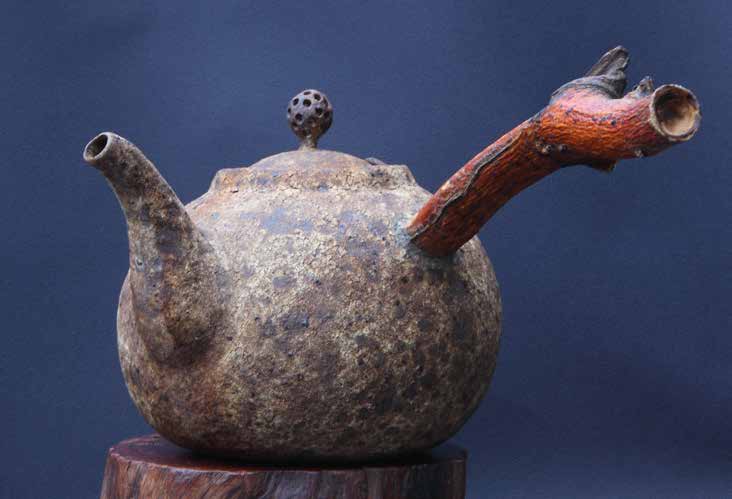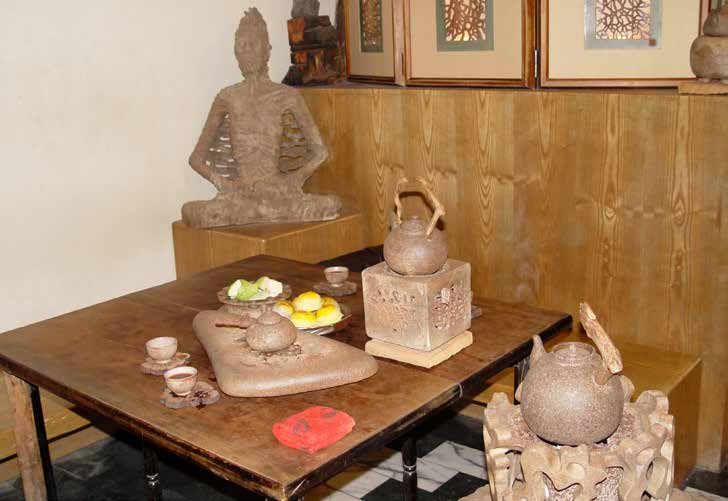
 |
|
Most of the various approaches to tea can be classified as either scientific or intuitive. Amongst the tremendous variation within these categories, most focus on the production, history and appreciation of tea or the aesthetic and spiritual sensation inspired by tea and Cha Dao. Of course, these approaches aren't mutually exclusive, and a more holistic understanding of tea would be found in the town where these two roads meet. Chen Qi Nan might just be the mayor of such a town. He fills his work with passion and artistic integrity, capturing the spirit of nature and the silent Dao. But Master Chen couples this aesthetic force with his background in science, bringing a unique function to the preparation of tea. This harmony of beauty and function has made him and his work famous in Taiwan.

Master Chen was born in Jia Yi in southern Taiwan. He graduated from university with a degree in electrical engineering and began a successful career and family. At the age of 27 he started taking pottery lessons from Master Ching Hua. "From the very first time I touched the clay it resonated deep in my soul," he says. As he advanced in his art, his career and life made less sense to him, and in 1994, Master Chen decided to try to make a living from his art. He opened the "Eight Piece Ceramic Art Studio" with his wife and six friends. The next several years would be very difficult ones for Master Chen. "One must suffer for their art," he laughs. All six of his friends closed their shops and returned to their previous careers when the art failed to reward them. Master Chen and his family also faced financial hardship. They had to sell their more practical pieces, like plates and bowls, at a roadside stand or market and even then often failed to make ends meet. Master Chen eventually tried returning to work as an engineer, but he confesses that "my heart just wasn't in it." He finally decided that come rain or come shine his life would be one of artistic integrity: "My years of Qi Gong had taught me to be sensitive to my inner self. I chose to live without regret." And when he put his heart and soul into his art without regard for accreditation or financial reward, people in Taiwan began to notice. In the last few years, Master Chen has seen a dramatic improvement. Not only has he won awards for his sculpture and teaware, but also his innovations have captured the interest of tea connoisseurs island-wide and in Mainland China.
The presence in Master Chen's work is selfevident, though the intelligence, experimentation and long hours of thought behind his innovations may be harder to notice. Master Chen said he started with the knowledge that the quality of water is one of the most important aspects of tea preparation. Because many lack access to the purest water from a good mountain spring, he invented a kind of kettle designed to rectify water quality. Master Chen experimented with hundreds of kinds of clay, mixing different regions with various amounts of sand and stone. In the end, he created very porous clay that is both sturdy and retains heat beyond normal clay; it is also gorgeous in an unaffected way. "The mountain stone, sand and clay are capable of changing the quality of water," he says. "Even if tap water is left in a stainless steal kettle and one of my kettles side by side for several days, the water in the clay kettle will be very different." He says that the unique composition of the clay and its high porosity make the difference. We also find that the water prepared in his kettles was soft and sweet.

Master Chen then approached his work with fuel sources in mind. He says he experimented with several methods of heating water and found that water heated on natural hardwood charcoal is best. Amongst all the charcoal he has tried, he prefers that made from the branches of long yan trees and that the best charcoal is imported from Malaysia, because "it smells nice, heats the water quickly and has very clean Qi." At first he found it difficult to construct a clay furnace capable of withstanding the heat of the charcoal, but after much trial and error, Master Chen developed a unique method of using his special clay to create thick walls that trap the heat. He then applies a coating of another clay he developed that can withstand the tremendous heat generated by the stove. In order to make all of these innovations, every aspect of the creative process had to be modified. "Being an electrical engineer helped me, since I had to take apart my kilns and make my own controls so that I could adjust the heat to the desired temperature at specific points in the firing." Master Chen also mentions that he often uses a wood-fired kiln, especially for his more artistic pieces. We found that the combination of his unique stove and kettle does indeed make incredible water for tea. Not only do the kettle and stove retain heat and maintain higher water temperature, but they also added a soft texture and gentle sweetness to the tea. We also tested spring and tap water both boiled in one of Master Chen's kettles with hardwood charcoal and found them to be almost indistinguishable. The stones in the clay kettle seem to mineralize the water in a way similar to products like bamboo charcoal.

Engineering complete, Master Chen could focus on the aesthetics of his unique teaware. He always knew that he wanted his teapots and kettles to have a naturalistic presence that would connect the tea drinker to the mountain, tree and river - the Dao and spirit of the Earth and sky. All of the stones, sands and clay mixtures that he experimented with were gathered at the source by himself. "I have gone hiking in the mountains every day for many years. My two sons used to come along every day before school when they were younger. 'An education in Nature before school,' we called it." Master Chen says he knew that wood was the missing element. He began experimenting with various roots, vines and branches, incorporating them into his artwork. "It took some time and many mistakes to master the control of the wood. First I had to scour the mountains for a more interesting piece of wood. It should be alive so it is more pliable and can be slightly bent." The second obstacle was attaching the wood to the fired pot. He knew he didn't want to use any form of glue; he wanted his pieces to be natural, through and through. Through his creativity and ingenuity, Master Chen developed a unique kind of stoneware clay, comparable to cement, that he uses to attach the wooden handles to the teapots and kettles. The result is a stunning blend of tree and mountain, water and heat that any tea lover would recognize and applaud.

Master Chen's kettles, stoves, teapots and other art have contributed a distinctive approach in both form and function to the aesthetics and preparation of tea. We have found that his small teapots are especially good for preparing Shou Puerh. Their ability to retain heat well and their porosity make them an excellent part of any collection. They add a simplicity that speaks to the heart of the tea ceremony, and the water that flows from them enhances any tea. The beauty of Master Chen's pieces can halt a tea session, inspiring our senses to move outdoors to a meditation on our connection to Nature. The sweet water that lovingly embraces any tea, when sipped, was enough to silence this author...
"I want my work to illicit Great Nature and be a pleasure to use. I am passionate about tea, and so I make my pieces with function in mind. I use them myself, after all."
